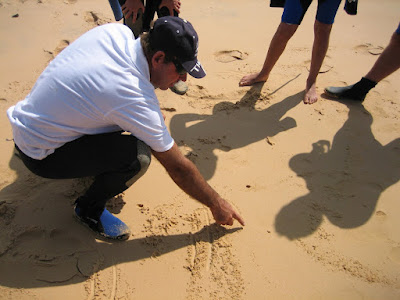After two days of travel through the-middle-of-nowhere Northern Mozambique, we arrived in Vilankulo. We were pretty excited to spend a few days NOT sitting on buses, and would have settled for any dusty little African town, but were pleasantly surprised by Vilankulo, a cute little beach town situated on the central coast of Mozambique. The farther south we traveled in Mozambique the more we entered into South African vacation territory. Vilankulo was far enough north not to be packed with sunburned vacationers, but popular enough to have some basic tourist amenities (like pizza and bacon!!!!!). I know I’ve mentioned this before, but the food in Zambia and Malawi was pretty mediocre, so Chris and I were really excited to get some decent grub.
In Vilankulo, we stayed in a cute little hut at a lodge managed by a local Mozambican couple. We enjoyed lounging around, cooking over the woodfire stove in the outdoor kitchen and wandering around checking out the town. The real highlight, however, was diving in the Bazaruto Archipelago.
The Archipelago has been a marine reserve for years, so its reefs have been protected from fishing. We did two fantastic dives at 2-mile reef, and enjoyed an afternoon exploring the sand dunes of Bazaruto Island. We also did a day-trip to Santa Carolina Island which was AMAZING and by far my favorite of the two excursions. We heard about this island from two Dutch girls that we met while traveling. It’s a looooong boat ride from Vilankulo and off the radar of most travelers, but definitely worth the extra effort to get there. The water was too shallow for diving, but it was perfect for snorkeling. This was probably the most beautiful snorkel spot I’ve seen since Sipadan in Borneo and Apo Island in the Philippines (which are both world class marine reserves). The water was crystal clear, and there were so many beautiful corals and schools of fish. We got to swim with turtles too, which was very, very cool. Santa Carolina itself was like a deserted island paradise. A luxury resort was built there in the 1950’s, but was abandoned during Mozambique’s long civil war. The hotel has yet to be rebuilt, so for now, it’s an isolated island with a slightly eerie ghost-town feel. After lunch on the island and a little time exploring the abandoned hotel, we headed back to Vilankulo, with the sun at our back, watching dolphins swim and play alongside the boat.
Yup, this is paradise, and I couldn’t be happier.
-Julia
 |
| From 08-18-10 Vilankulo and N. Moz Web |
Vilankulo Beach




















